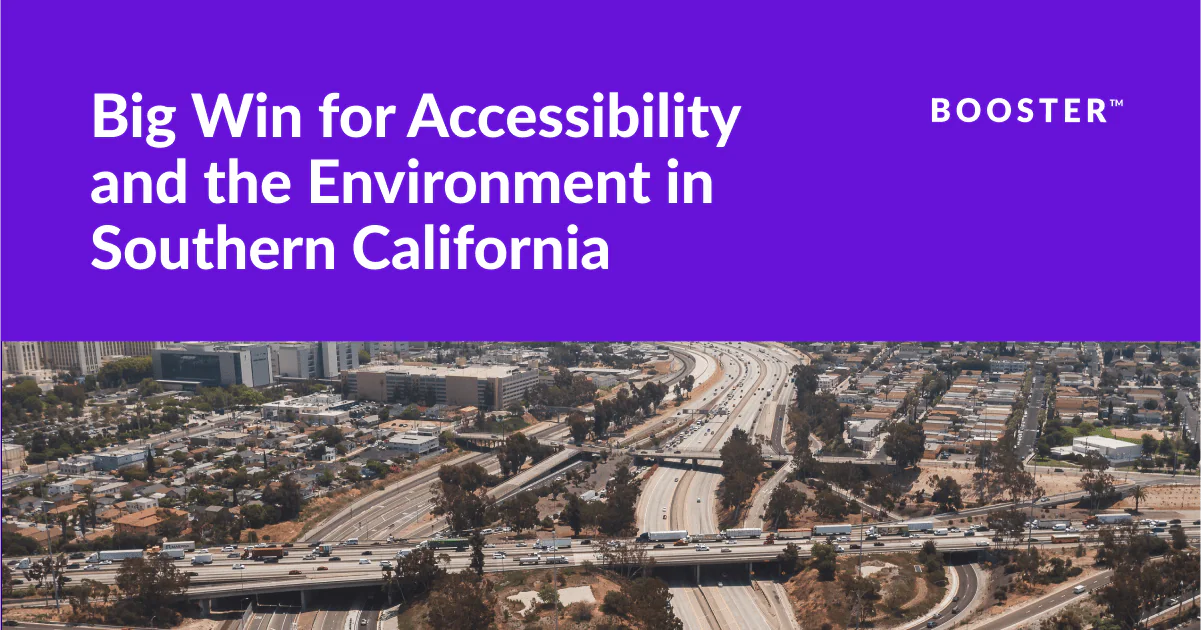Earlier this month, the South Coast Air Quality Management District (SCAQMD) amended its rules to allow for responsible mobile fueling throughout its region. This isn’t just a big deal for Booster, it’s also a huge win for the environment and people with disabilities throughout Los Angeles, Orange, Riverside and San Bernardino counties.
So, what’s this all about?
In the early 1990’s, the EPA mandated that gas stations install systems that prevent fuel vapors from being released into the atmosphere (known as Stage II Vapor Recovery). Today, most vehicles produced have their own built-in systems called On-Board Refueling Vapor Recovery (ORVR). This made the need for gas station recovery systems obsolete.
In 2012, the EPA removed this guidance and many states followed suit by eliminating the requirement for Stage II Vapor Recovery systems. However, California did not follow the EPA’s updated guidance and as a result air districts, including the SCAQMD, kept the Stage II Vapor Recovery requirements intact. Due to the lack of Stage II systems that can be installed on a mobile fueling tanker, Booster initially was not able to operate in the SCAQMD region.
How did Booster play a role in this?
Booster found a way to use technology and ingenuity to develop a new process that ensures that our operations in California meet or exceed the strictest standards in the country for reducing vapors when fueling vehicles.
To ensure that fuel vapors are properly recovered during our mobile fueling operations, we worked in partnership with the California Air Resources Board (CARB), California’s statewide air regulator, and developed proprietary technology that could take a vehicle’s license plate and run it through several databases to check if it had ORVR. If a vehicle did not meet these requirements, we would not fuel it. After several years of testing and refining this system, this project led to the first ever certification to be issued by CARB for a mobile fueling operation like Booster, which means that Booster’s operations meet the state’s extremely high environmental standards. This was the first executive order of its kind issued by CARB in over 20 years. It also ultimately led to this significant SCAQMD rule change.
And why is enabling mobile fueling important to residents in the SCAQMD?
For one, it’s the most accessible way for drivers with disabilities to stay fueled. It can be difficult or impossible for many of these drivers to use a standard self-serve gas pump. Even though the ADA requires accommodations at gas stations, too often this is either ignored or the infrastructure is just too out of date. By passing the new rule, SCAQMD has made steps to improve independence and mobility for many residents without increasing their costs.
And the new rule is great news for sustainability. Mobile fueling is fundamentally better for people, our communities and our planet. Our shortened supply chain reduces gasoline spills and the need for ground-polluting underground storage tanks. And by delivering fuel straight to vehicles, we saved our customers 1.3 million gas station strips in 2021. This translates to fewer miles driven, fewer gallons of gas consumed and, most importantly, fewer harmful emissions.
Great! Where do we go from here?
We believe in working closely with regulators and lawmakers because not only is mobile fueling safe, it’s actually better for our communities and the environment. Although this rule change is a step in the right direction, there are still numerous areas in California where mobile fueling is not allowed due to outdated rules.
Our next mission is to continue working so that a bill passes to allow safe, environmentally responsible mobile fueling to be offered to every Californian, regardless of where in the state they live.
